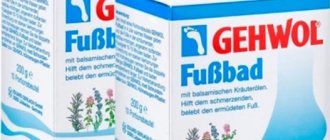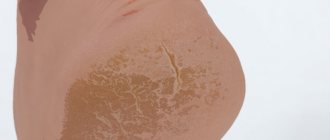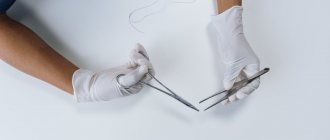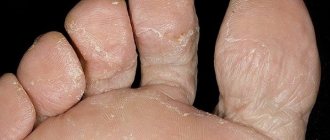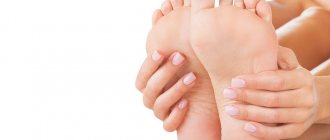Plantar hyperkeratosis is a thickening of the stratum corneum of the epidermis under the influence of physical factors affecting the foot. As the skin thickens, it becomes more resistant to damage and its sensitivity decreases. Hyperkeratosis is one example of the body's adaptive reactions to changing environmental conditions.
Hyperkeratosis becomes a problem in cases where, under the influence of a number of aggressive factors, the metabolism and fluid in the skin of the feet is disrupted, the skin loses elasticity and firmness, as well as mechanical strength.
This leads to the appearance of dry, bleeding or weeping cracks, deep calluses, which cause anxiety and sometimes cause serious pain that limits a person’s physical activity.
Cracks on the feet
Cracks are an obligatory companion to hyperkeratosis of the feet. Excessively thick skin that has lost its elasticity can no longer resist the loads that arise when walking as effectively as before. Cracks appear in places of greatest pressure. Their favorite location is the heels.
Typically, the crack is wider at the surface of the skin and narrows deeper. With prolonged existence, the edges of the cracks also become keratinized and thickened.
However, this does not lead to a cure. On the contrary, when walking, such a crack deepens even more and begins to bleed. In severe cases, cracks can reach the bone.
Cracks in the arms or legs due to various diseases
If the symptom is caused by the reasons described above, it should go away fairly quickly after they are eliminated. In other cases, you need to sound the alarm - this means there is a disease that requires urgent treatment. Wounds that do not heal for more than 2 weeks or appear too often cannot be eliminated using home remedies - a comprehensive approach to treatment under the guidance of a doctor is required.
Here is a list of diseases that can cause cracks.
- Hormonal disorders. Dryness of the epidermis accompanies any pathology of the thyroid gland, as well as diabetes. If the underlying disease is not treated, there is a high probability of complications in the form of damage to internal organs and the nervous system.
- Malfunctions of the gastrointestinal tract. The connection between the digestive process and the external state of the body is ensured through metabolism. With ulcers, gastritis and dysbiosis, the blood does not receive enough nutrients, which negatively affects the elasticity of the epidermis. As a result, it becomes dry and dehydrated.
- Eczema. The disease is dangerous because it quickly becomes chronic and cannot always be corrected. Painful wounds are one of the first signs of illness. Symptoms also manifest themselves in the form of peeling, severe itching, and sometimes hyperemia.
- Fungus on fingers. In most cases, it affects the lower extremities, which is associated with insufficient hygiene or visiting public places without shoes (for example, public showers or baths). Less commonly, fungus develops on the hands, but it is no less dangerous in this case. Once pathogenic microorganisms have settled in a certain place, it is extremely difficult to expel them from there. The infection also often spreads to the nails, contributing to their destruction.
- Psoriasis. Contrary to popular belief, this autoimmune disease is not infectious in nature, so you cannot become infected with it. The development of the disease is caused by a complex internal imbalance, due to which it is impossible to completely cure psoriasis - it can only be corrected, and in some cases it is possible to completely eliminate its manifestations.
Types of cracks and reasons for their appearance
Cracks in the feet can be of two types:
- dry, when the skin loses its elasticity as a result of a decrease in natural moisture levels;
- wet, when maceration of the skin occurs due to constantly increased humidity.
The appearance of wet cracks is promoted by:
- foot hyperhidrosis;
- working in rubber boots;
- work in baths, saunas and other places where humidity is high;
- wearing closed shoes, as well as shoes made of materials that do not allow air and moisture to pass through easily.
Factors that provoke the appearance of dry cracks include:
- decreased sweat production with peripheral polyneuropathy;
- diabetes;
- liver dysfunction;
- lead poisoning;
- psoriasis;
- neurodermatitis;
- ichthyosis;
- incorrectly selected shoes;
- various foot deformations that lead to improper redistribution of the load when walking;
- fungal infections of the skin of the feet;
- overweight.
Fortunately, the diseases listed above are not that common, and the main causes of cracked heels are shoes and fungal infections. However, there is no need to relax. Only a doctor can conduct an examination, prescribe the necessary liver tests, identify concomitant pathologies and prescribe competent treatment.
Diagnosis of plantar hyperhidrosis and fissures
Diagnostics involves an examination by a specialist and, if necessary, the appointment of the necessary examination. That is why it is so important that one medical center has a podologist, a dermatologist, and a laboratory equipped with everything necessary.
An examination for possible concomitant pathology may be necessary to identify factors that support the development of hyperkeratosis, and to prescribe adequate treatment that will be safe for the patient.
Factors that cause cracks to appear
The skin on the arms and legs is highly sensitive, so it can withstand aggressive external influences with great difficulty. Deep, poorly healing cracks in the fingers, feet and palms are one of the most unpleasant problems that modern people face. Sores on the legs create discomfort while walking, which significantly impairs the quality of life. As for injuries on the upper extremities, they present primarily an aesthetic problem. In addition, the cracked areas of the epidermis hurt upon any contact with anything.
Vinikli nutrition - consult a doctor
To make an appointment for a consultation, call or fill out the return form:
(050) 301-99-26 (067) 446-11-79
Damn,
Your request has been successfully sent!
A call center specialist will contact you as soon as possible to clarify all the details.
The appearance of such a symptom should alert you, since it often turns out to be a signal of the presence of a serious systemic disease. For diagnostic purposes, it is recommended to visit a therapist or dermatologist. The doctor will examine the painful area, make a preliminary diagnosis and prescribe the necessary tests. The sooner you contact a specialist, the greater the chances of avoiding complications. In addition, you need to understand that poorly healing wounds are an open door for pathogens, and if left untreated, the risk of infection increases significantly.
There are several factors that cause cracks in the legs or arms.
- Hypovitaminosis. Increased dryness of the skin is caused by a lack of vitamins A and E. As a rule, a lack of nutrients occurs in the winter-spring period, when there is an acute shortage of plant foods in the diet.
- Exposure to cold. This factor affects the hands and palms to a greater extent, since they are the ones that are most exposed to frost in winter if you are in the habit of walking without gloves. The epidermis dries out and loses its initial elasticity, which causes partial tears.
- Inconvenient or poor quality shoes. In order to save money, people buy shoes and boots made of cheap materials, in which their feet sweat and are subject to severe friction. Such shoes interfere with blood circulation in the feet and injure the delicate skin. Wearing shoes that are too narrow or wide has a similar effect.
- Working with household chemicals without gloves. Aggressive components of detergents destroy epidermal cells, dehydrating them and depriving the skin of the hands of some collagen.
Treatment of plantar hyperhidrosis and fissures
Removal of the hard stratum corneum on the skin of the feet can be done in different ways. For this the following can be used:
- chemical softeners;
- disposable instruments: scalpels and hollow blades;
- polishing the skin using files and attachments.
Podological procedures require jeweler's precision from the specialist performing them: it is necessary to remove the stratum corneum, but not to harm the delicate pink skin. That is why our clinic employs podologists with medical education.
Are you worried about cracked heels? Make an appointment and get rid of your problem today!
The appearance of dryness and cracks in the foot area is only a separate symptom of various diseases. The main dermatological diseases that may be accompanied by such symptoms include fungal infections of the feet, eczema, atopic dermatitis, psoriasis and many others.
The following symptoms are characteristic of mycotic lesions of the feet: the disease usually begins with damage to the interdigital spaces, after which it spreads to the skin of the feet. In this case, the skin becomes dry, thickened, with many furrows; with a long course of the disease, deep cracks, rough calluses, peeling, and pain appear. In this case, the only effective method of treatment will be the use of antifungal drugs locally or systemically, for which you need to consult a dermatovenerologist.
Similar symptoms occur with a type of eczema called tylotic (horny). In this case, areas of thickened epithelium appear on the palms and soles, which then crack to form deep, painful fissures. To make a correct diagnosis, in addition to examination, a histological examination of the affected areas is sometimes required. Treatment is pathogenetic and symptomatic: prescribe a hypoallergenic diet, eliminate contact with a possible provoking antigen, use glucocorticosteroid drugs, sedatives, antihistamines and others.
The form of psoriasis of the same name (callous) leads to damage to the palms and soles and is characterized by the appearance of areas of hyperkeratosis (increased keratinization) with the formation of layers similar to calluses. Such areas alternate with healthy ones, which serves as a diagnostic criterion. In severe cases, the entire skin of the feet and palms may be involved. This pathology can be diagnosed by the characteristic clinical picture, as well as by histological examination. Treatment includes the use of special dressings with steroid hormonal drugs, vitamin complexes, and in severe cases, phototherapy sessions are performed.
Simple contact dermatitis or atopic dermatitis can also cause skin lesions on the feet. With a long course of atopic dermatitis, the skin of the feet becomes thickened, the skin pattern deepens, peeling, dryness and significant cracks appear, and the presence of itching of varying severity is also characteristic. Chronic simple contact dermatitis is characterized by infiltration, hyperemia of the skin of the feet and the development against this background of significant hyperkeratosis with cracks and dryness. Treatment depends on the stage and severity of the manifestations and may include glucocorticoids, vitamin A, antihistamines, moisturizers, antibacterial drugs and many others.
There are also many non-dermatological causes of cracks, calluses and dry skin on the feet. These may be somatic diseases such as hypothyroidism, chronic venous or arterial insufficiency of the lower extremities, diabetes mellitus, severe hypovitaminosis, anemia and many others. Improper care of the skin of the feet, wearing uncomfortable shoes, prolonged static load can also cause skin damage.
For diagnosis in dermatovenerological practice, clinical examination and collection of complaints are of greatest importance. It is necessary to examine not only the affected area, but also the entire skin, noting all the features of the skin, the presence of various morphological elements of the rash. From the anamnesis it is necessary to clarify the time of onset of this condition, whether it could be associated with any specific factor, whether treatment was carried out previously and what the effect was. If there are doubts about the correct diagnosis or lack of effect from treatment, a histological examination of the biopsy specimen is performed, which allows the correct diagnosis to be made with sufficient accuracy. In the absence of specific changes, the doctor may refer the patient for consultation to another specialist: a therapist or an endocrinologist. Of the laboratory and instrumental methods to clarify the diagnosis, general and biochemical blood tests, hormonal studies (thyroid hormones, pituitary gland, steroid hormones), ultrasound Doppler Doppler, color circulation of the vessels of the lower extremities, angiography and others can be prescribed.
Treatment is prescribed only after the cause of the disease has been established. In the absence of pathology, the patient can be given recommendations on hygiene, physical activity and nutrition, and moisturizers can be recommended.
The most effective remedies against dry and cracked heels
Among cosmetic and medicinal products, there is a huge selection of products to combat increased heel dryness and cracking. The best are:
- Vaseline.
- Ciel Parfum.
- Gehwol Med.
- Dexeryl.
- TianDe.
- Calendula ointment.
These products have a unique composition and effectively treat cracked heels, softening and moisturizing the skin of the feet.
What is onychorrhexis or crack along the nail?
The beauty of your nails directly depends on their health.
It’s hard to disagree that well-groomed nails can add neatness and neatness to an image. But not in every situation the beauty of nails can be achieved with a regular manicure or pedicure. In some cases, the nail plates have serious defects, which are manifestations of somatic pathologies. Such manifestations require the intervention of a podiatrist. Violations of the integrity of the nail plate, delamination or brittleness of the nails require not only aesthetic closure with gel polish, but also treatment.
One type of nail deformation is onychodystrophy.
Onychodystrophy is a group of diseases of the nail plate, which are characterized by the appearance of changes in the color of the nail, its shape or structure. One of the pathologies of the group of onychodystrophies is onychorrhexis.
Onychorrhexis is a type of structural change in the nail plate, in which its longitudinal separation occurs. In appearance, the pathology resembles a nail crack running from the free edge to the base. The bundle can be single or multiple. As a rule, multiple onychorrhexis occurs on the fingernails, while on the feet the nail plates of the big toes are more often affected.
Onychorrhexis occurs equally often in women and men. If we single out an age category that is more susceptible to pathology, then these are elderly people.
Cracked toenail, what should I do? Such a complaint is a good reason to consult a podiatrist. The specialist will conduct a thorough examination of the defect, find out its etiology, and also draw up a treatment plan for the nail plate defect.
Treatment of cracks between toes
There are several ways to cure cracked toes. Any method is aimed at eliminating the cause of the development of this symptom:
- If the cracks are caused by uncomfortable shoes, then you need to change them to another one.
- In case of vitamin deficiency, it is necessary to provide the body with a sufficient amount of vitamins and microelements.
- If you have fungus, it is recommended to wash your feet with regular laundry soap. This pathology requires treatment with antifungal drugs, otherwise complications in the form of suppuration and the addition of a bacterial infection are possible.
Vaseline or lanolin cream can help eliminate dry feet. The fingers are generously lubricated with any of the products, after which cotton socks are put on. The main treatment for cracks is aimed at softening the skin and eliminating its dryness. For this purpose, the following methods and means are used:
- Soda baths. For 2 liters of hot boiled water, take a quarter of a bar of tar soap (grated), 1 tsp. baking soda. After mixing the ingredients, the solution is poured into a basin. The feet are kept in it for about 20-40 minutes. At the end of the procedure, the feet are thoroughly dried and lubricated with nourishing cream.
- Lotions. For these procedures, decoctions of medicinal herbs are used, for example, chamomile, calendula, and sage.
- Lubrication with SixtuMed oil. This method is used for diabetes mellitus, because steaming your legs is prohibited with this disease. The oil is based on medicinal plants that exhibit antifungal and antibacterial properties. Add a couple of drops of this product to warm water. The bath is taken for 15-20 minutes, then the feet are dried and lubricated with SixtuMed balm.
- Hardware pedicure. Helps with deep cracks, removes the upper stratum corneum of the skin. One procedure per month is enough for complete recovery.
Medications
The choice of specific medications depends on the cause of your cracked toes. This is necessary so that the treatment eliminates not only the symptom, but also the provoking factor. Depending on the nature of the cracks, the following treatment regimens can be used:
- For dry calluses. Complex treatment with a compress with Shostakovsky balm, after which the skin is lubricated with Solcoseryl gel or Radevit ointment, is effective. If your skin is too dry, it is recommended to use Dardia cream. It provides hydration and elasticity to the skin.
- For fungal infection. It is necessary to use antimycotic agents, both local and oral. For external application, terbinafine-based creams are recommended: Lamisil, Thermikon. When local treatment does not help, you need to start taking pills that destroy the fungus from the inside. For this purpose, agents based on fluconazole, miconazole, clotrimazole, and ciclopirox are used.
- For diabetes mellitus. In the case of such a disease, due to possible contraindications, not all medications are used. SixtuMed oil and balm are allowed, they moisturize and protect the skin.
- For painful cracks. Painkillers help relieve this symptom. An example is the drug Ketanov. It is very strong, so before using such a remedy you should try to relieve pain with Analgin, Ibuprofen or Nimesil.
Each group of drugs includes several remedies that can be used for cracked fingers. You should not prescribe them yourself. If, after regular use of your chosen medication, a positive effect does not occur, then you should seek help from a doctor. The cause of cracks may be fungus. In this case, medications are prescribed taking into account the causative agent of the disease, which can only be identified through tests. In general, the following drugs are effective and proven against cracked fingers:
- Solcoseryl. This is an ointment based on hemoderivat from calf blood. The main effect of the drug is to activate tissue metabolism, which helps stimulate tissue regeneration. Solcoseryl is indicated for the treatment of difficult-to-heal wounds, burns, frostbite, and trophic skin disorders. Before using the ointment, treat the skin with a disinfectant solution. Next, the product is applied in a thin layer to the wound surface. Do this 2-3 times a day. An adverse reaction may include allergies, swelling, urticaria, and hyperemia. Contraindication is intolerance to benzoic acid. The advantage of Solcoseryl is the safety of the composition.
- Lamisil. Available in the form of tablets, ointments and sprays based on terbinafine. They are used to treat mycoses, onychomycosis, foot fungus, ringworm of the trunk or legs, and lichen versicolor. Tablets are taken at 250 mg daily. The ointment and spray are applied to the affected area in a thin layer 1-2 times a day. Lamisil should not be used for liver disease. Adverse reactions can occur from the nervous, immune, digestive, and musculoskeletal systems. Pros of Lamisil: compliance with international standards, wide spectrum of antifungal activity, safety, speed of action.
- SixtuMed. This is a special product for diabetics, which increases the protective function of the skin, helps soften it and promotes rapid tissue restoration. The composition of the oil includes plant components: sage, clove, angustifolia lavender. They have antibacterial, anti-inflammatory and antifungal effects. Oil is added to warm water (temperature up to 36 degrees). For 4-5 liters of liquid take 1 tsp. facilities. Leave your feet in the bath for 7-10 minutes. Then wipe the feet dry, especially the spaces between the toes. SixtuMed balm is applied to already dry skin. Do not use products from this line on open wounds and ulcers. Advantages of SixtuMed: high safety and hypoallergenic.
Traditional methods
If the cause of the cracks is not a fungus or another serious disease, then the problem can be eliminated using folk remedies. They can also be used additionally during drug treatment. Compresses, decoctions, and baths reduce inflammation and heal the skin. The following folk recipes help to achieve this effect:
- For 2 liters of hot water, take 1 tsp. mineral soap and 1 tbsp. l. soda Pour the solution into a bowl. Soak your feet in it for 10-15 minutes. Then dry the skin thoroughly and then apply cream.
- At night, apply a soft cloth soaked in liquid honey to your feet. Wrap the top of the foot with a bandage. In the morning, rinse them, dry them and lubricate them with rich cream or olive oil.
- Dissolve 1 tsp in 1 liter of hot water. boric acid. Leave your feet in this solution for 10-15 minutes. Next, dry your feet thoroughly and generously lubricate them with Vaseline.

